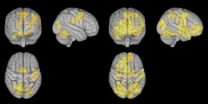(Press-News.org) Mindfulness. Zen. Acem. Meditation drumming. Chakra. Buddhist and transcendental meditation. There are countless ways of meditating, but the purpose behind them all remains basically the same: more peace, less stress, better concentration, greater self-awareness and better processing of thoughts and feelings.
But which of these techniques should a poor stressed-out wretch choose? What does the research say? Very little – at least until now.
A team of researchers at the Norwegian University of Science and Technology (NTNU), the University of Oslo and the University of Sydney is now working to determine how the brain works during different kinds of meditation. Their most recent results were published in the journal Frontiers in Human Neuroscience.
Different meditation techniques can actually be divided into two main groups. One type is concentrative meditation, where the meditating person focuses attention on his or her breathing or on specific thoughts, and in doing so, suppresses other thoughts.
The other type may be called nondirective meditation, where the person who is meditating effortlessly focuses on his or her breathing or on a meditation sound, but beyond that the mind is allowed to wander as it pleases. Some modern meditation methods are of this nondirective kind.
"No one knows how the brain works when you meditate. That is why I'd like to study it," says Jian Xu, who is a physician at St. Olavs Hospital in Trondheim, Norway and a researcher at the Department of Circulation and Medical Imaging at NTNU.
Fourteen people who had extensive experience with the Norwegian technique Acem meditation were tested in an MRI machine. In addition to simple resting, they undertook two different mental meditation activities, nondirective meditation and a more concentrative meditation task.
The research team wanted to test people who were used to meditation because it meant fewer misunderstandings about what the subjects should actually be doing while they lay in the MRI machine.
Nondirective meditation led to higher activity than during rest in the part of the brain dedicated to processing self-related thoughts and feelings. When test subjects performed concentrative meditation, the activity in this part of the brain was almost the same as when they were just resting.
"I was surprised that the activity of the brain was greatest when the person's thoughts wandered freely on their own, rather than when the brain worked to be more strongly focused," said Xu. "When the subjects stopped doing a specific task and were not really doing anything special, there was an increase in activity in the area of the brain where we process thoughts and feelings. It is described as a kind of resting network. And it was this area that was most active during nondirective meditation."
"The study indicates that nondirective meditation allows for more room to process memories and emotions than during concentrated meditation," says Svend Davanger, a neuroscientist at the University of Oslo, and co-author of the study.
"This area of the brain has its highest activity when we rest. It represents a kind of basic operating system, a resting network that takes over when external tasks do not require our attention. It is remarkable that a mental task like nondirective meditation results in even higher activity in this network than regular rest," says Davanger.
Most of the research team behind the study does not practice meditation, although three do: Professors Are Holen and Øyvind Ellingsen from NTNU and Professor Svend Davanger from the University of Oslo.
Acem meditation is a technique that falls under the category of nondirective meditation. Davanger believes that good research depends on having a team that can combine personal experience with meditation with a critical attitude towards results.
"Meditation is an activity that is practiced by millions of people. It is important that we find out how this really works. In recent years there has been a sharp increase in international research on meditation. Several prestigious universities in the US spend a great deal of money to research in the field. So I think it is important that we are also active," says Davanger.
INFORMATION:
This is your brain on meditation
Meditation can really help you process thoughts and feelings
2014-05-15
ELSE PRESS RELEASES FROM THIS DATE:
HIV patient nutrition more vital than once assumed
2014-05-15
Roughly 25 million Africans live with HIV, many of who now have access to antiretroviral drugs (ARVs). Among their side effects, ARVs can cause patients to put on weight. Subsequently, attention paid to malnutrition among African HIV patients has waned. However, widespread malnutrition has been identified as a reason that up to a quarter of HIV patients in a number of African countries die just months after beginning medical treatment.
A collaborative project between the University of Copenhagen and Jimma University, Ethiopia has demonstrated that daily nutritional supplementation ...
The state of rain
2014-05-15
Using modern weather satellites to monitor rainfall has become a robust, widely practiced technique. However, establishing a reliable context for relating space-based rainfall observations to current and historical ground-based rainfall data has been difficult.
A new dataset developed in partnership between UC Santa Barbara and the U.S. Geological Survey (USGS) can be used for environmental monitoring and drought early warning. The Climate Hazards Group Infrared Precipitation with Stations (CHIRPS), a collaboration between UCSB's Climate Hazards Group and USGS's Earth ...
Study finds hazardous flame retardants in preschools
2014-05-15
Berkeley — A new study of preschools and day care centers finds that flame retardants are prevalent indoors, potentially exposing young children to chemicals known to be hazardous.
The study, to appear online Thursday, May 15, in the journal Chemosphere, was led by researchers at the University of California, Berkeley, and funded by the California Air Resources Board. Although many infants and young children spend up to 50 hours per week in day care, the study authors noted that this paper represents the first systematic review of flame retardants in early child care ...
West Antarctic Ice Sheet collapse is under way
2014-05-15
The West Antarctic Ice Sheet, which holds enough water to raise global seas by several feet, is thinning. Scientists have been warning of its collapse, based on theories, but with few firm predictions or timelines.
University of Washington researchers used detailed topography maps and computer modeling to show that the collapse appears to have already begun. The fast-moving Thwaites Glacier will likely disappear in a matter of centuries, researchers say, raising sea level by nearly 2 feet. That glacier also acts as a linchpin on the rest of the ice sheet, which contains ...
Phase I data suggest PLX3397 is a potential therapy for patients with advanced PVNS
2014-05-15
NEW YORK, NY, May 14, 2014 — A novel targeted drug shows promise in treating patients with advanced pigmented villonodular synovitis (PVNS), a rare neoplastic joint disorder, according to new phase I data from Memorial Sloan Kettering Cancer Center and other institutions highlighted to media today in advance of the 50th Annual Meeting of the American Society of Clinical Oncology (ASCO), which will take place from May 30 to June 3 in Chicago.
At the time of interim analysis, 11 of 14 evaluable patients (79 percent) had a partial response to the drug and three patients ...
Critical access hospitals have higher transfer rates after surgery
2014-05-14
Hospital transfers happened more often after surgery at critical access hospitals (CAHs) but the proportion of patients using post-acute care was equal to or less than that of patients treated at non-CAHs.
The CAH designation was created to provide financial support to rural hospitals. As such, they are exempt from Medicare's Prospective Payment System and instead are paid cost-based reimbursement. The proliferation of CAHs after the payment policy change has increased interest in the quality and cost of care these facilities provide.
The authors used data from ...
Study examines prenatal exposure to tobacco smoke on inhibition control
2014-05-14
Individuals prenatally exposed to tobacco smoke exhibited weaker response in some regions of the brain while processing a task that measures inhibition control (the ability to control inappropriate responses).
Prenatal tobacco smoke exposure is a risk factor for adverse physical and mental outcomes in children. Growing evidence suggests that smoking during pregnancy may increase the risk of psychopathology such as attention-deficit/hyperactivity disorder (ADHD). Research on ADHD has suggested that individuals with the disorder may exhibit poor inhibitory control.
Functional ...
Reduction in volume in hippocampus region of brain seen in psychotic disorders
2014-05-14
Reduction in brain volume in the hippocampus (a region related to memory) was seen in patients with the psychotic disorders schizophrenia (SZ), schizoaffective disorder (SZA) and psychotic bipolar disorder (BPP).
The pathophysiology of psychotic disorders remains unclear, especially SZ. Changes in volume in the hippocampus are a hallmark of SZ. Advances in image processing allow for the precise parceling of specific hippocampal areas.
The authors conducted a neuroimaging study in patients with psychotic disorders and healthy volunteers as part of the multisite ...
MAVEN solar wind ion analyzer will look at key player in Mars atmosphere loss
2014-05-14
This past November, NASA launched the Mars Atmosphere and Volatile Evolution (MAVEN) mission in the hope of understanding how and why the planet has been losing its atmosphere over billions of years.
One instrument aboard the spacecraft will study a special component of the Martian atmosphere to help solve this mystery. By studying ions, or small electrically charged particles, in and above the Red Planet's tenuous atmosphere, the Solar Wind Ion Analyzer will help answer why Mars has gradually lost much of its atmosphere, developing into a frozen, barren planet.
Once ...
Different approaches needed to control cardiovascular disease risks for those with HIV
2014-05-14
Even if treated, hypertension and high cholesterol are increasingly common for people with human immunodeficiency virus (HIV), according to a new study from researchers at Mount Sinai St. Luke's and Mount Sinai Roosevelt hospitals in New York and the University of California, Davis.
The finding – published online in the Journal of Acquired Immune Deficiency Syndromes – leads the study authors to recommend greater emphasis on cardiology in HIV treatment and research.
The study authors examined medical records for a diverse group of 4,278 outpatients in New York City ...
LAST 30 PRESS RELEASES:
Heart-brain connection: international study reveals the role of the vagus nerve in keeping the heart young
Researchers identify Rb1 as a predictive biomarker for a new therapeutic strategy in some breast cancers
Survey reveals ethical gaps slowing AI adoption in pediatric surgery
Stimulant ADHD medications work differently than thought
AI overestimates how smart people are, according to HSE economists
HSE researchers create genome-wide map of quadruplexes
Scientists boost cell "powerhouses" to burn more calories
Automatic label checking: The missing step in making reliable medical AI
Low daily alcohol intake linked to 50% heightened mouth cancer risk in India
American Meteorological Society announces Rick Spinrad as 2026 President-Elect
Biomass-based carbon capture spotlighted in newly released global climate webinar recording
Illuminating invisible nano pollutants: advanced bioimaging tracks the full journey of emerging nanoscale contaminants in living systems
How does age affect recovery from spinal cord injury?
Novel AI tool offers prognosis for patients with head and neck cancer
Fathers’ microplastic exposure tied to their children’s metabolic problems
Research validates laboratory model for studying high-grade serous ovarian cancer
SIR 2026 delivers transformative breakthroughs in minimally invasive medicine to improve patient care
Stem Cell Reports most downloaded papers of 2025 highlight the breadth and impact of stem cell research
Oxford-led study estimates NHS spends around 3% of its primary and secondary care budget on the health impacts of heat and cold in England
A researcher’s long quest leads to a smart composite breakthrough
Urban wild bees act as “microbial sensors” of city health.
New study finds where you live affects recovery after a hip fracture
Forecasting the impact of fully automated vehicle adoption on US road traffic injuries
Alcohol-related hospitalizations from 2016 to 2022
Semaglutide and hospitalizations in patients with obesity and established cardiovascular disease
Researchers ‘listen in’ to embryo-mother interactions during implantation using a culture system replicating the womb lining
How changing your diet could help save the world
How to make AI truly scalable and reliable for real-time traffic assignment?
Beyond fragmented markets: A new framework for efficient and stable ride-pooling
Can shape priors make road perception more reliable for autonomous driving?
[Press-News.org] This is your brain on meditationMeditation can really help you process thoughts and feelings




